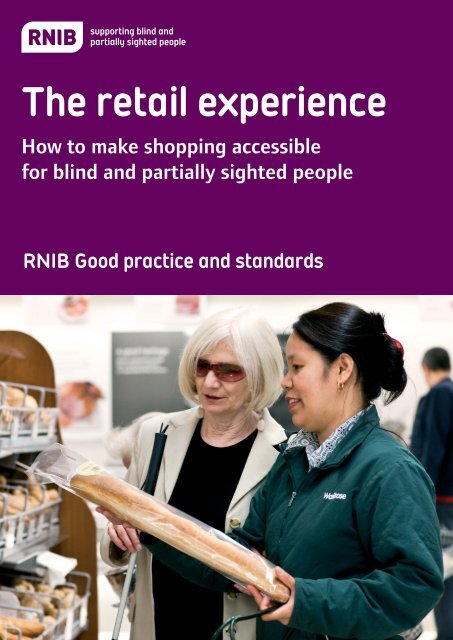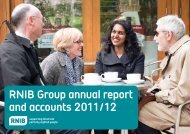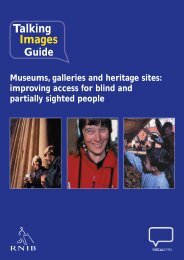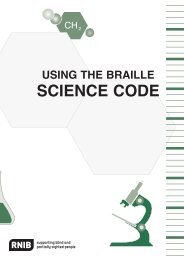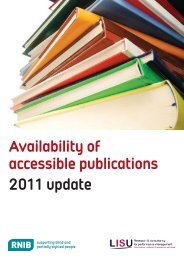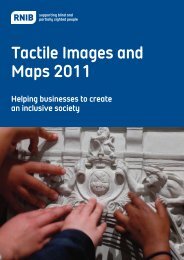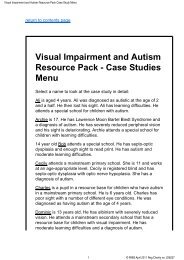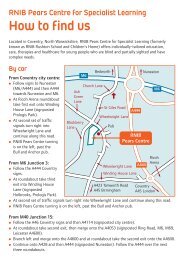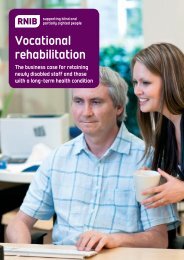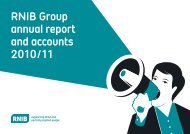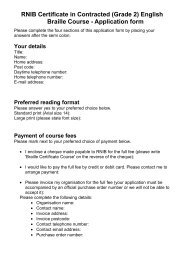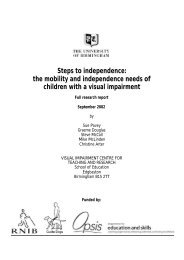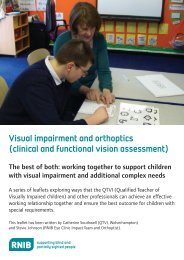The retail experience - RNIB
The retail experience - RNIB
The retail experience - RNIB
Create successful ePaper yourself
Turn your PDF publications into a flip-book with our unique Google optimized e-Paper software.
<strong>The</strong> <strong>retail</strong> <strong>experience</strong><br />
How to make shopping accessible<br />
for blind and partially sighted people<br />
<strong>RNIB</strong> Good practice and standards
Contents<br />
Contents<br />
3 Foreword<br />
4 Who should read this guide<br />
5 <strong>The</strong> costly truth<br />
6 What can customers with sight problems see?<br />
7 How to improve the shopping <strong>experience</strong> of customers<br />
with sight loss<br />
13 Become an outstanding <strong>retail</strong>er<br />
l Top ten tips to make shopping more accessible today<br />
for customers with sight loss<br />
l Guiding basics for people with sight loss<br />
17 Go! Shop<br />
18 Support from <strong>RNIB</strong>: working towards an accessible future<br />
20 Acknowledgements and contacts<br />
2
Foreword<br />
Foreword<br />
Going shopping is an activity which most people take for granted, but for blind and<br />
partially sighted people it can create a range of challenges. Locating shop doorways,<br />
finding shop assistants to help and selecting and paying for goods can all pose<br />
significant difficulties.<br />
Making shopping accessible and enjoyable for blind and partially sighted customers<br />
isn’t difficult. It just requires <strong>retail</strong>ers to consider accessibility issues in their planning<br />
and ask blind and partially sighted customers what works for them. <strong>RNIB</strong> can help<br />
support you by improving access to your environments and connect you to blind and<br />
partially sighted consumers.<br />
<strong>RNIB</strong> has worked with other visual impairment organisations to produce this guide to<br />
support the <strong>retail</strong> industry. <strong>The</strong> guide sets out good practice in meeting the needs of<br />
blind and partially sighted customers throughout the shopping <strong>experience</strong>.<br />
<strong>The</strong> guide will assist large multiples and department stores as well as small independent<br />
<strong>retail</strong>ers. We hope that you will use the guide to improve the shopping <strong>experience</strong> for<br />
your existing and potential blind and partially sighted customers.<br />
Fazilet Hadi<br />
<strong>RNIB</strong> Group Director Inclusive Society<br />
3
Who should read this guide<br />
Who should read this guide<br />
<strong>The</strong> guide will assist large multiples and department stores as well as small independent<br />
<strong>retail</strong>ers. We want to support you to make the services you provide more accessible to<br />
blind and partially sighted people and help you think of ways to consult directly with<br />
your blind and partially sighted customers about their needs and how you can best<br />
meet them.<br />
<strong>RNIB</strong> accessibility statement<br />
<strong>RNIB</strong> believes that blind and partially sighted people should enjoy full access to the<br />
world around them. This includes being able to shop for goods and services in ways<br />
which meet their particular needs and makes shopping an enjoyable <strong>experience</strong>. We are<br />
committed to work with the <strong>retail</strong> industry to achieve these aims.<br />
Equality Law<br />
<strong>The</strong> Equality Act 2010 requires providers to make their goods and services accessible to<br />
disabled people. This can include altering a policy or practice, or changing the way a<br />
service is delivered so that disabled people can fully benefit. For detailed information on<br />
changes to previous legislation, please refer to the Government Equalities Office<br />
website www.equalities.gov.uk<br />
4
<strong>The</strong> costly truth<br />
<strong>The</strong> costly truth<br />
Almost two million people in the UK are living with sight loss. Bottom line: how much of<br />
this substantial and lucrative market is your business missing out on?<br />
Key barriers to accessibility<br />
Based on findings from a survey of 150 blind and partially sighted people [1]:<br />
l<br />
l<br />
l<br />
l<br />
l<br />
79 per cent stated that if a shop is difficult to navigate, it would stop them shopping<br />
there again<br />
96 per cent <strong>experience</strong>d difficulty reading signs<br />
95 per cent <strong>experience</strong>d difficulty reading labels<br />
73 per cent had to avoid obstacles in aisles<br />
89 per cent felt their shopping <strong>experience</strong> would be improved if the shop assistant<br />
would just read out their bill.<br />
[1] One hundred and fifty blind and partially sighted members tell us about their<br />
<strong>experience</strong> of shopping as part of a telephone survey for Go! Shop, <strong>RNIB</strong> 2009/10.<br />
Visit rnib.org.uk/goshop for more information.<br />
Small improvements to your services will not only benefit your business but will have a<br />
positive impact on the shopping <strong>experience</strong> for blind and partially sighted people and<br />
create loyal customers.<br />
To make your services accessible to blind and partially sighted people, this guide<br />
will help you to address the key barriers to shopping <strong>experience</strong>d by customers with<br />
sight loss.<br />
5
What can customers with sight problems see?<br />
What can customers with sight<br />
problems see?<br />
Being blind does not always mean that a<br />
person is living in total darkness. Many<br />
blind people and the majority of partially<br />
sighted people can recognise a friend at<br />
arm’s length.<br />
Other people will be affected by eye<br />
conditions in different ways: some will<br />
have no central vision or no vision to the<br />
sides; others may see a patchwork of<br />
blank and defined areas, or else<br />
everything may be seen as a vague blur.<br />
<strong>The</strong> pictures on this page will give you<br />
some idea of what people may see, but it<br />
should be remembered that people are<br />
affected by eye conditions in different<br />
ways. You should not assume that you<br />
know what people can see simply<br />
because you know what eye condition<br />
they have.<br />
Glaucoma can result in tunnel vision,<br />
where all side vision is lost and only<br />
central vision remains.<br />
Glaucoma<br />
Diabetic retinopathy<br />
Diabetic retinopathy can cause blurred<br />
or patchy vision.<br />
Macular degeneration can lead to a loss<br />
of central vision whilst side vision remains.<br />
Macular degeneration<br />
6
How to improve the shopping <strong>experience</strong> of customers with sight loss<br />
How to improve the shopping<br />
<strong>experience</strong> of customers with<br />
sight loss<br />
<strong>RNIB</strong> has researched the shopping journeys of many blind and partially sighted people<br />
from the time they contemplate going to the shops to paying for their goods.<br />
Implementing good practice standards at key barrier points in the shopping journey<br />
will transform the negative <strong>experience</strong>s of blind and partially sighted people into<br />
positive ones.<br />
Getting to and arriving at the shops<br />
“When there’s a person like me who is blind or<br />
other people as well who are partially sighted, a<br />
staff member should come up to them and say<br />
‘Would you like to be helped?’, ‘Is there<br />
anything I can do?’, ‘Can I show you anything or<br />
can I point anything out to you?’ or ‘Would you<br />
mind being helped?’”<br />
Many blind and partially sighted shoppers <strong>experience</strong> difficulty locating and navigating<br />
escalators, stairs, steps, lifts and ramps.<br />
Good practice<br />
l Apply colour contrast (a combination of light and dark eg dark text on a light<br />
background) hazard strips to the edge of escalator steps, stairs and handrails.<br />
l Provide accessible hand-held maps eg tactile, large print or “Map for All”.<br />
If staff see someone with a sight problem who they think may need help, they should<br />
introduce themselves, make sure the person knows they are speaking to them, explain<br />
who they are, and ask if assistance is needed. Let them state what kind of help they<br />
may need.<br />
7
How to improve the shopping <strong>experience</strong> of customers with sight loss<br />
Individual guiding needs will vary but following the guidelines set out in the back of<br />
this guide will equip your staff with practical advice and information to feel confident<br />
about guiding people with sight problems.<br />
For information about tactile flooring and accessible maps refer to page 19.<br />
Customer care<br />
A person who is blind has a high degree of vision loss.<br />
About 18 per cent of blind people are totally blind –<br />
most can distinguish between light and dark. People<br />
who are partially sighted have a less severe loss of<br />
vision. It is important for your staff to be aware that<br />
not all people with sight loss carry a white cane or use<br />
a guide dog, and not all deaf-blind people carry a<br />
white cane with red bands. Blind and partially sighted<br />
people do of course shop independently but others<br />
may need assistance.<br />
Good practice<br />
l Designate a clearly defined “customer service” area adjacent to the entrance that<br />
customers know is monitored and that they can wait there for assistance.<br />
l When your staff see a customer in need of assistance, they should introduce<br />
themselves, explain who they are, and ask if assistance is needed.<br />
l Offer assistance to shoppers by guiding and helping them throughout the<br />
shopping journey.<br />
For information about Visual awareness training and guiding courses, refer to page 18.<br />
Navigating and locating<br />
“My friend picks, I push the trolley. <strong>The</strong> main<br />
problem for me is the fact that sometimes the staff<br />
in the supermarket leave the pallets in the aisles,<br />
or there might be something left on the floor.<br />
<strong>The</strong>se are the kinds of things I can’t see and will<br />
bang in to. Similarly, they might have a floor<br />
cleaner out – like a buffer – with a cable. You<br />
might be able to make out the machine because<br />
it’s quite big, but the cable can trip you up.”<br />
Getting around and finding the right products can be difficult especially when goods<br />
are periodically rearranged.<br />
8
How to improve the shopping <strong>experience</strong> of customers with sight loss<br />
Good practice<br />
l Keep aisles as clutter free as possible with enough space for easy navigation<br />
including with a guide dog or sighted guide.<br />
l If using floor signs, fit sensors and position where they do not block the aisles.<br />
l Make it easier for customers to find the Customer Services/ Information stand.<br />
We suggest that the stand should be sited close to the main entrance.<br />
For information about making buildings accessible (Buildings audit), refer to page 19.<br />
Selecting clothing<br />
“I got into the shop and all I could hear was a lot of<br />
indistinct noise. I thought I’d aim for the sides of<br />
the shop and made my way towards the sound of<br />
people talking. I asked them where the jumpers<br />
were. I didn’t know if they were staff or customers.<br />
But one of them said, ‘Here are some jumpers’. I<br />
said that I was blind and that I couldn’t see and she<br />
took me to them – she didn’t ask whether I wanted<br />
to be guided, she kind of held my shoulder. I later<br />
found out the woman I had asked was a member of<br />
staff – although she never said so. I asked her to tell me what jumpers there were<br />
for sale. She said there were some grey, black and red jumpers. I said I’d like a grey<br />
jumper and she said there were normal or long styles. She didn’t offer to describe<br />
the style or designs of the jumpers – like whether they were high or low neck, the<br />
texture or anything. All she said was ‘there are long or normal styles’.”<br />
Some shoppers may need assistance with selecting fashion items. It is important to<br />
allocate suitable staff to ensure effective communication and a better understanding of<br />
your customers’ needs.<br />
Good practice<br />
l Offer a dedicated service to assist with the fashion needs of men and women<br />
including fitting, styling and colours.<br />
l Provide a small selection of clothing for customers to choose from including<br />
different ages and gender.<br />
For information about producing accessible documents and making your website<br />
accessible (Access audits – websites), refer to page 18.<br />
9
How to improve the shopping <strong>experience</strong> of customers with sight loss<br />
Selecting food products<br />
“Another problem for me, shopping alone, is that I<br />
find it hard to read small details – so I’ll miss out<br />
on being able to find the best bargains and the<br />
promotions because I can’t see them. For someone<br />
with sight they’ll be able to make comparisons<br />
between products in the same range. That’s harder<br />
for me. I tend to stick to what I know no matter<br />
what, which means people like me tend to have to<br />
pay more for our shopping.”<br />
Making sense of overhead signs, label, pricing and packaging information is a major<br />
obstacle to fully accessing the services you provide. Accessible information should be<br />
available in store on sale items, special offers, benefits available to shoppers with<br />
disabilities and your refund and returns policies. Accessibility also extends to your<br />
website so you should ensure such information is also available online and that your<br />
website is designed to be compatible with access technology supported software.<br />
Good practice<br />
l Use large print text throughout the store but preferably not block capitals. <strong>The</strong><br />
usual mixture of upper and lower case letters makes word recognition easier for<br />
people with impaired vision.<br />
l All of your staff should know which products have braille labelling eg<br />
pharmaceuticals and bleaches.<br />
l Introduce larger font sizes on packaging for important information such as expiry<br />
dates, cooking procedures etc.<br />
l<br />
l<br />
l<br />
l<br />
l<br />
Lighting should be diffused or directed away from shoppers to avoid glare, which<br />
can be uncomfortable or painful. All circulation areas and displays should be well<br />
lit with no significant changes in light level.<br />
Introduce colour contrast packaging which helps consumers with a visual<br />
impairment that will also suit the needs of mainstream shoppers.<br />
Introduce large print labels on clothing detailing relevant information (eg size,<br />
washing instructions)<br />
Introduce audio labelling on all products. This would enable people with an audio<br />
labeller, such as the <strong>RNIB</strong> PenFriend, to identify the goods they have purchased<br />
when they get home.<br />
If your staff provides assisted shopping, ensure your customer is advised of all<br />
relevant information on the goods they require such as different brands,<br />
varieties, prices, special offers etc.<br />
10
How to improve the shopping <strong>experience</strong> of customers with sight loss<br />
Paying for goods<br />
“When I was at the check out, they gave me my<br />
change but in my opinion, it wasn’t given correctly<br />
to a person like me that’s blind. Say, for instance,<br />
I gave them £20. In turn they should have said,<br />
‘Here’s a five pound note, a two pound coin, a one<br />
pound coin and a ten pence piece and put it<br />
properly in my hand and said ‘put it away safe<br />
before you leave the store’.”<br />
Differing chip and pin machines with small screen displays and having to quickly<br />
identify coins, bank notes and credit cards can be stressful and leads to queue delays.<br />
Good practice<br />
l At point of sale, your sales staff should read out the final cost of the shopping bill,<br />
confirm the amount of money handed to them, and count out any change handed<br />
back to the customer placing the change and receipt in the customer’s hand.<br />
Card and cash payments<br />
“I usually pay by debit card. I’m happy enough<br />
dealing with cash, but I often use the cash-back<br />
service at the supermarket rather than making a<br />
separate trip to the cash point. <strong>The</strong> chip and pin<br />
machines are sometimes awkward because they<br />
don’t all use the same layout.”<br />
11<br />
Good practice<br />
l Ensure that your staff can process customer payments using Chip and Signature<br />
cards, if required.<br />
l Introduce large button chip and pin (PED) machines with a standardised number<br />
layout, with a raised button (or blister) on the number 5 to assist with identification.<br />
l Assistance may be needed to place credit cards into (PED) machines and with<br />
locating the number 5 digit. Your staff should enquire if assistance is needed.<br />
l Ensure that your (PED) machines do not incorporate additional or complex menu<br />
items and selections as part of the transaction.<br />
l Your sales staff should be advised not to put crisp flat banknotes and springy<br />
receipts onto a customer’s hand on top of coins. <strong>The</strong>y very often fall off before<br />
the customer can close his/her hand on them.<br />
For information about Product Design Consultancy, refer to page 18.
How to improve the shopping <strong>experience</strong> of customers with sight loss<br />
On departure<br />
“I then had to make my way back to the exit of the<br />
store unassisted. Overall, I felt the <strong>experience</strong> of<br />
shopping there an unpleasant one. I felt<br />
uncomfortable and anxious. When I asked for<br />
assistance, [the response] it was only half hearted.”<br />
It makes good business sense for your customers to<br />
leave your establishment having had a good shopping<br />
<strong>experience</strong>.<br />
Good practice<br />
l Staff should guide customers back to the shop entrance and enquire whether<br />
transport is required eg a taxi.<br />
12
Become an outstanding <strong>retail</strong>er<br />
Become an outstanding <strong>retail</strong>er<br />
<strong>RNIB</strong> is working with service providers to develop beacons of good practice,<br />
organisations that can serve as exemplars of top quality customer service for blind and<br />
partially sighted people.<br />
Top ten tips to make shopping more accessible today<br />
for customers with sight loss<br />
1. Take a walk around one of your stores – are the aisles clutter free?<br />
A step further: Talk to <strong>RNIB</strong> about an expert guided walk, get a copy of BS8300<br />
from BSI or talk to a qualified consultant about improving store design. Also talk to<br />
<strong>RNIB</strong>’s wayfinding team to find out about new solutions and to link into our<br />
exciting pilots. Visit rnib.org.uk/<strong>retail</strong><br />
2. Ask your web experts if your website is easily accessible for someone using<br />
access technology.<br />
A step further: Visit rnib.org.uk/wac to get lots of free information about web<br />
access design and other useful facts.<br />
3. Check your packaging – does it have clear font size and layout?<br />
A step further: Check your packaging against <strong>RNIB</strong> See it Right guidelines or ask<br />
our experts to review it for you. Ensure it has clear layout, good visual contrast and<br />
a clear font. Visit rnib.org.uk/seeitright<br />
4. Try to pay with a chip and signature card.<br />
A step further: Ensure your customer facing staff know what to do with<br />
chip and signature card payments and remind them about it through internal<br />
staff magazines.<br />
5. Be “cash clever” – tell customers how much to pay, and how much change<br />
there is.<br />
A step further: Ensure your customer-facing staff confirms the total amount<br />
payable and count out cash handed back to all customers including cash back<br />
amounts. People like to know which notes they are given.<br />
13
Top ten tips to make shopping more accessible<br />
6. Make friends with your local shoppers.<br />
A step further: Find out about blind and partially sighted people local to your<br />
outlets and involve them in changes you make. Ask them about their <strong>experience</strong>s<br />
– can you make things better?<br />
7. Encourage helpful staff – ensure sight loss is covered in training.<br />
A step further: Staff are invaluable to customer perceptions of service in stores.<br />
Ensure your staff are confident and willing to help by building on their training with<br />
regular updates in staff magazines, volunteering and fundraising opportunities.<br />
8. Identify the best products – find out which products are useful for people<br />
with sight loss.<br />
A step further: Get a list of <strong>RNIB</strong> referenced products and build accessibility into<br />
your procurement process for new products. Ensure all your staff know about<br />
helpful products such as those with larger buttons or displays – and that they can<br />
confidently explain the benefits. Visit rnib.org.uk/productdesign<br />
9. Work outside in – link into wayfinding and transport networks.<br />
A step further: Have a phone line in your store for calling a taxi company who<br />
welcomes customers with a range of disabilities. Find out the nearest bus stops,<br />
and link in to local systems such as minibus services or <strong>RNIB</strong> React installations.<br />
Visit rnib.org.uk/react<br />
10. Become an outstanding <strong>retail</strong>er.<br />
A step further: Work with <strong>RNIB</strong> to profile your business, or a particular part of your<br />
business, to others within your sector. This can help you to attract positive PR, more<br />
customers and lead to customer retention too. Find out more by calling us on<br />
01733 37 53 45 or emailing busdev@rnib.org.uk<br />
14
Guiding basics for people with sight loss<br />
Guiding basics for people with sight loss<br />
If your offer of assistance is accepted, ask where the person wants to go and how they<br />
would like to be guided. Ask if they would like to take your arm and if there is room to<br />
walk side by side, stand next to them and let them take hold of your arm with their<br />
fingers in the crook of your elbow.<br />
You can keep your arm pointing downwards or you can bend it, as long as you keep<br />
your upper arm straight. By walking hand to arm in this way the person you are guiding<br />
will be at least half a pace behind you, making it easier to tell when you are turning by<br />
the movement of your body.<br />
Steps, stairs and slopes:<br />
l<br />
When you approach steps or a slope, tell the person you are guiding whether the<br />
steps go up or down. Wherever possible, they should be on the side with the<br />
handrail. If you need to change sides, inform the customer of your intention then ask<br />
them to stand still and let go of your guiding arm to allow you to come alongside.<br />
Walk towards the handrail and show its position with your guiding arm.<br />
l<br />
l<br />
l<br />
l<br />
As you begin to go up steps, the person you are guiding will feel your arm move<br />
when you place your weight on the first step. This is their cue to start. As you climb<br />
the second step, they are on the first. Tell them when you have reached the last step,<br />
stop and allow them to find it with their foot. When they feel their arm resume its<br />
normal position they will know that you are both on the level again.<br />
Going downstairs is always more difficult so give the person you are guiding plenty<br />
of time to hold onto the handrail securely and gauge the edge of the first step.<br />
Otherwise the technique is the same for going upstairs. Walk one step ahead, stop at<br />
the bottom and tell them there are no more steps.<br />
If you’re not as tall as the person you are guiding, arm movements are not so clearly<br />
felt, especially as they may have their hand on your shoulder. If you take your first<br />
step with the foot on the same side as your guiding arm, the movement is more<br />
obvious.<br />
If the person you are guiding has a guide dog, the dog may be a substitute for the<br />
handrail or they may prefer to use both handrail and dog, rejoining you at the bottom<br />
of the steps. Approach the person from the side opposite to the dog and do not take<br />
hold of the harness or lead, as the guide dog owner needs this to control the dog.<br />
Some people prefer to walk at your side without holding your arm. In some situations<br />
you can also walk in front and the dog will follow you.<br />
15
Guiding basics for people with sight loss<br />
Escalators, travelators and lifts:<br />
l<br />
Many blind and partially sighted people prefer to avoid escalators so if you are<br />
approaching one, ask the person you are guiding if they are happy to use it or if they<br />
would prefer an alternative. When you are using an escalator, inform the customer<br />
when they are either approaching or on the stepping on/off threshold plate, guide<br />
them to the moving handrail and say whether you are going up or down. It is<br />
sometimes best if the person you are guiding negotiates the first step by themselves,<br />
as escalators are often too narrow to take people side by side. If possible, move<br />
ahead on the escalator once you have checked the person you are guiding is safely<br />
on it, so that you can help them off. If there is no alternative to using an escalator,<br />
you can ask that the escalator is turned off.<br />
l<br />
l<br />
l<br />
Travelators should be used in the same way and you will need to say when you are<br />
reaching the end.<br />
It is not safe to take a dog on a moving escalator or travelator so you may need to<br />
find an alternative. <strong>The</strong> dog might need to be carried if there is no alternative.<br />
Discuss how you will do this or indeed if it is practical.<br />
Lifts are straightforward. Walk in side by side, if possible, and say whether you are<br />
moving up or down. Some people may prefer to be next to the lift wall so that they<br />
can steady themselves.<br />
16
Go! Shop<br />
Go! Shop<br />
Go! Shop is an <strong>RNIB</strong> project bringing blind and partially sighted people together with<br />
<strong>retail</strong> and transport companies to improve the shopping <strong>experience</strong>, from getting to the<br />
shops to paying for their goods. <strong>The</strong> following individuals from the <strong>retail</strong> industry were<br />
presented with <strong>RNIB</strong>’s “Go! Shop” awards for demonstrating outstanding levels of<br />
customer service:<br />
Helen Vint, Boots<br />
During research, Helen demonstrated a natural, intuitive focus on the customer and<br />
immediately offered her assistance to Liz, who has no sight, when she entered the store.<br />
Helen provided a full description of the product Liz wished to purchase and guided her<br />
through the special offers available.<br />
Michelle Moncaster, Co-op, Trelawney Crescent<br />
Michelle has assisted Liz with her shopping for some time and it has now developed<br />
into a partnership of trust. Michelle directs Liz to the special offers, alerts her to the sell<br />
by dates, pushes the trolley and helps her pack her bags so that Liz knows where<br />
everything is when she unpacks.<br />
Ian Puxty, Beacon Footwear, Lincoln<br />
A father and son establishment, Beacon Footwear has demonstrated an innovative<br />
solution to meet the needs of Valerie, who is partially sighted. Ian Puxty delivered a<br />
large quantity of footwear for Valerie to choose from in the comfort of her own home.<br />
Lauren Partington from the Card Shop<br />
Lauren instinctively took a great deal of trouble to help a blind and partially sighted<br />
person by explaining the size of the cards, what they looked like, and what the occasion<br />
was for each card. This simple and intuitively helpful human interaction was vital in<br />
making the shopping <strong>experience</strong> less of an ordeal and avoiding potential social faux pas!<br />
Marie Higgins, Tesco, Bagley<br />
A personal shopper relationship has built up over some time so its now a real<br />
partnership. Maria Higgins directs Marie, who is blind, to the special offers, alerts her to<br />
the sell-by dates, pushes the trolley and helps her pack her bags, so that Marie knows<br />
what is where when she unpacks.<br />
Visit rnib.org.uk/goshop for more information.<br />
17
Support from <strong>RNIB</strong><br />
Support from <strong>RNIB</strong>: working<br />
towards an accessible future<br />
Accessible documents<br />
<strong>RNIB</strong> can help make all of your documents accessible for your customers. We can<br />
convert your information into braille, large print, e-text or audio as specified by your<br />
customer and either deliver through your store or directly to your customer. This service<br />
regularly handles information ranging from in-store leaflets and flyers through to more<br />
complicated documents such as magazines and even corporate information for your<br />
shareholders. Using our secure services, we can also provide confidential information on<br />
your behalf such as invoices, statements or loyalty card communications.<br />
For more information on accessible documents, please call 01733 37 53 70 or email<br />
businesslink@rnib.org.uk<br />
Consultancy services<br />
Our Consultancy services can help support you by improving access to your<br />
environments and services. Services available to you include:<br />
l<br />
l<br />
l<br />
Visual and disability awareness training courses that aim to give your customer-facing<br />
staff more confidence in reaching customers with disabilities. <strong>The</strong>se courses can be<br />
modified to meet your specific need and are well suited to cascading skills through<br />
training your trainers.<br />
Website audit and certification to ensure that your online presence is accessible. We<br />
also offer a range of training courses aimed at website owners, website designers,<br />
content authors and marketing personnel.<br />
Design consultancy to ensure that your products and communications are accessible.<br />
We undertake ergonomic assessments of products and undertake user testing to<br />
ensure that your products are both accessible and easy to use, awarding our coveted<br />
<strong>RNIB</strong> Reference benchmark to the best products. We can also advise on your print<br />
and graphic design, helping your designers find a balance between creativity and<br />
accessibility.<br />
18
Support from <strong>RNIB</strong><br />
l<br />
l<br />
Access audits of existing buildings and design appraisals of both new buildings and<br />
redevelopments. We will assess all of the features of your property and recommend<br />
practical solutions to overcome any potential issues.<br />
We can also help you to provide the information that empowers blind and partially<br />
sighted people to be more independent in your store. This includes our <strong>RNIB</strong> “Map<br />
for All”, which is a bespoke static map that enables blind and partially sighted people<br />
to comprehend the layout of your store.<br />
For more information on any of our Consultancy services, please call 01733 37 53 70 or<br />
email businesslink@rnib.org.uk<br />
Opening the blind and partially sighted market to you<br />
As a respected <strong>retail</strong>er, you will be proud that your offer is accessible to all and want<br />
blind and partially sighted customers to enjoy your services. At <strong>RNIB</strong>, we publish a<br />
variety of media channels that you may wish to consider in your marketing<br />
communications plan to target your offer at this audience. This includes Insight radio,<br />
<strong>RNIB</strong>’s own radio station with an audience of 85,000 listeners each week and Vision<br />
magazine, our membership magazine with a bi-monthly readership of 14,000.<br />
For more information on promoting your services, please call 020 7391 3297 or email<br />
businesslink@rnib.org.uk<br />
Making your services accessible to blind and partially sighted shoppers will help you<br />
gain and retain loyal customers.<br />
<strong>RNIB</strong> can support you to implement reasonable adjustments and by working together<br />
with its partners, good practice standards will be achieved.<br />
19
Acknowledgements and contacts<br />
Acknowledgements and contacts<br />
Acknowledgements<br />
This publication was developed by <strong>RNIB</strong> in partnership with key organisations which<br />
provide services and support to people with sight loss. We would like to thank the<br />
following people and organisations for their insight during the production of this guide:<br />
l<br />
l<br />
l<br />
l<br />
Niamh Connolly and members of National Council for the Blind of Ireland (NCBI)<br />
Laura Matthews and members of Action on Hearing Loss (formerly RNID)<br />
Douglas Gilroy and members of the National Federation of the Blind of the<br />
United Kingdom<br />
Anthony Slater and customers of the Thomas Pocklington Trust.<br />
Contacts<br />
<strong>RNIB</strong><br />
Telephone: 0303 123 9999<br />
Email: helpline@rnib.org.uk<br />
Website: rnib.org.uk<br />
<strong>The</strong> Royal National Institute of Blind People (<strong>RNIB</strong>) is the UK’s leading charity offering<br />
information, support and advice to almost two million people with sight loss and to<br />
people who work within the sight loss community.<br />
Our Innovation and Development teams work in partnership with industry to develop<br />
accessible technologies and services across a range of sectors. Our focuses include<br />
shopping, finance and payment systems, travel, mobile devices and emerging<br />
technologies.<br />
Our Commercial Services develop and deliver practical, efficient and effective solutions<br />
for organisations that are facing accessibility challenges.<br />
<strong>The</strong> Evidence and Service Impact team develops and disseminates good practice<br />
standards by working directly with blind and partially sighted people, service providers<br />
and regulators to research issues and improve the impact of services for customers.<br />
20
National Council for the Blind of Ireland<br />
(NCBI)<br />
Telephone: +353 1 830 7033<br />
Email: info@ncbi.ie<br />
Website: www.ncbi.ie<br />
NCBI is a not-for-profit charitable organisation, who provides support and services<br />
nationwide to people experiencing sight loss as well as a range of services to voluntary,<br />
public and private organisations to help them make their services accessible to people.<br />
Action on Hearing Loss<br />
(formerly RNID)<br />
Telephone: 020 7296 8000<br />
Email: informationline@rnid.org.uk<br />
Website: www.rnid.org.uk<br />
Action on Hearing Loss is the largest charity in the UK tackling hearing loss, offering a<br />
range of services for people who are deaf or hard of hearing and providing information<br />
and support on all aspects of deafness, hearing loss and tinnitus.<br />
Thomas Pocklington Trust<br />
Telephone: 020 8995 0880<br />
Email: info@pocklington-trust.org.uk<br />
Website: www.pocklington-trust.org.uk<br />
Thomas Pocklington Trust is a leading provider of housing, care and support services for<br />
people with sight loss in the UK. <strong>The</strong>y provide sheltered, supported and independent<br />
housing; residential and respite care; day and resource centres, and volunteer-based<br />
community support services. Each year they also fund a programme of social and public<br />
health research and development projects.<br />
National Federation of the Blind of the United Kingdom<br />
(NFBUK)<br />
Telephone: 01924 291313<br />
Email: nfbuk@nfbuk.org<br />
Website: www.nfbuk.org<br />
NFBUK is an independent, non-political, self help campaigning<br />
pressure group and registered charity. Through representation and<br />
campaigning, the Federation strives to improve all aspects and quality<br />
of daily life for blind, partially sighted and deaf-blind people, and<br />
those whose sight impairment is part of multi-disability, in the UK.
<strong>RNIB</strong> believes that blind and partially sighted people should<br />
enjoy full access to the world around them. This includes being<br />
able to shop for goods and services in ways which meet their<br />
particular needs and makes shopping an enjoyable <strong>experience</strong>.<br />
We are committed to work with the <strong>retail</strong> industry to achieve<br />
these aims.<br />
This guide will support you to make the services you provide<br />
more accessible to blind and partially sighted people. And of<br />
course, you should always consult directly with your blind and<br />
partially sighted customers about their needs and how you can<br />
best meet them.<br />
Royal National Institute of Blind People<br />
105 Judd Street<br />
London<br />
WC1H 9NE<br />
0303 123 9999<br />
helpline@rnib.org.uk<br />
rnib.org.uk<br />
© <strong>RNIB</strong> April 2011 Registered charity no. 226227


